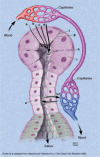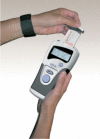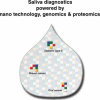Salivary diagnostics: enhancing disease detection and making medicine better
- PMID: 18289265
- PMCID: PMC2674509
- DOI: 10.1111/j.1600-0579.2007.00477.x
Salivary diagnostics: enhancing disease detection and making medicine better
Abstract
To monitor health status, disease onset and progression, and treatment outcome non-invasively is a most desirable goal in the health care delivery and health research. There are three prerequisites necessary to reach this goal: 1. A non-invasive method for collecting biological samples. 2. Specific biomarkers associated with health or disease. 3. A technology platform to rapidly discriminate the biomarkers. An initiative catalysed by the National Institute of Dental and Craniofacial Research (NIDCR) has created a roadmap to achieve this goal through the use of oral fluids as the diagnostic medium to scrutinize the health and disease status. This is an ideal opportunity to bridge state-of-the-art saliva-based biosensors and disease-discriminatory salivary biomarkers in diagnostic applications. Oral fluid, often called the mirror of the body, is a perfect medium to be explored for health and disease surveillance. The translational applications and opportunities are enormous. This review presents the translational value of saliva as a credible clinical diagnostic fluid and the scientific rationale for such use.
Figures






Similar articles
-
Salivary diagnostics.Orthod Craniofac Res. 2009 Aug;12(3):206-11. doi: 10.1111/j.1601-6343.2009.01454.x. Orthod Craniofac Res. 2009. PMID: 19627522 Free PMC article. Review.
-
Salivary diagnostics powered by nanotechnologies, proteomics and genomics.J Am Dent Assoc. 2006 Mar;137(3):313-21. doi: 10.14219/jada.archive.2006.0180. J Am Dent Assoc. 2006. PMID: 16570464
-
The Oral Fluid MEMS/NEMS Chip (OFMNC): diagnostic and translational applications.Adv Dent Res. 2005 Jun;18(1):3-5. doi: 10.1177/154407370501800102. Adv Dent Res. 2005. PMID: 16000263 Review.
-
Salivary biomarkers for clinical applications.Mol Diagn Ther. 2009;13(4):245-59. doi: 10.1007/BF03256330. Mol Diagn Ther. 2009. PMID: 19712004 Review.
-
Saliva: an emerging biofluid for early detection of diseases.Am J Dent. 2009 Aug;22(4):241-8. Am J Dent. 2009. PMID: 19824562 Free PMC article. Review.
Cited by
-
Salivary Markers for Periodontal and General Diseases.Dis Markers. 2016;2016:9179632. doi: 10.1155/2016/9179632. Epub 2016 Apr 6. Dis Markers. 2016. PMID: 27143814 Free PMC article. Review.
-
Overcoming challenges in human saliva gene expression measurements.Sci Rep. 2020 Jul 7;10(1):11147. doi: 10.1038/s41598-020-67825-6. Sci Rep. 2020. PMID: 32636420 Free PMC article.
-
Examining potential confounding factors in gene expression analysis of human saliva and identifying potential housekeeping genes.Sci Rep. 2022 Feb 10;12(1):2312. doi: 10.1038/s41598-022-05670-5. Sci Rep. 2022. PMID: 35145126 Free PMC article.
-
Biosensors in clinical chemistry - 2011 update.Clin Chim Acta. 2011 Sep 18;412(19-20):1749-61. doi: 10.1016/j.cca.2011.06.025. Epub 2011 Jun 26. Clin Chim Acta. 2011. PMID: 21729694 Free PMC article. Review.
-
Possible proteomic biomarkers for the detection of pancreatic cancer in oral fluids.Sci Rep. 2020 Dec 15;10(1):21995. doi: 10.1038/s41598-020-78922-x. Sci Rep. 2020. PMID: 33319845 Free PMC article.
References
-
- Mandel ID. Salivary diagnosis: more than a lick and a promise. J Am Dent Assoc. 1993;124:85–87. - PubMed
-
- Miller SM. Saliva testing – a nontraditional diagnostic tool. Clin Lab Sci. 1994;7:39–44. - PubMed
-
- Yager P, Edwards T, Fu E, et al. Microfluidic diagnostic technologies for global public health. Nature. 2006;442:412–418. - PubMed
-
- Ramachandran P, Boontheung P, Xie Y, Sondej M, Wong DT, Loo JA. Identification of n-linked glycoproteins in human saliva by glycoprotein capture and mass spectrometry. J Prot Res. 2006;5:1493–1503. - PubMed
Publication types
MeSH terms
Substances
Grants and funding
LinkOut - more resources
Full Text Sources
Other Literature Sources

